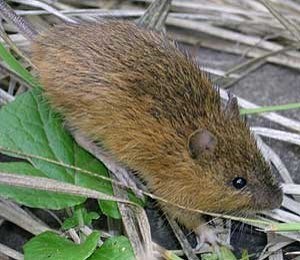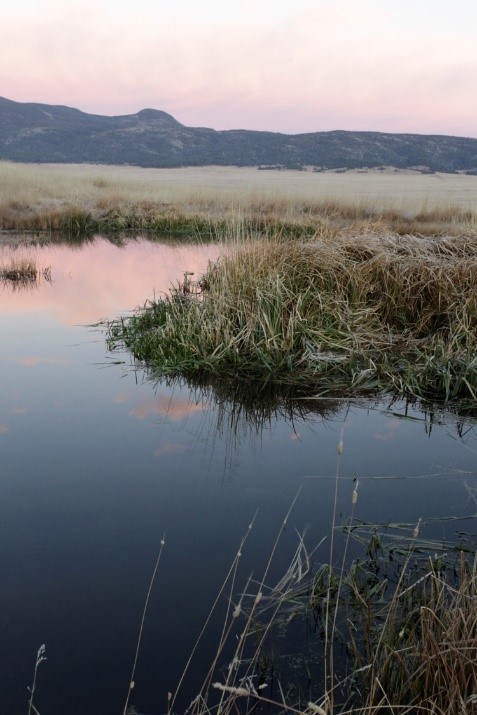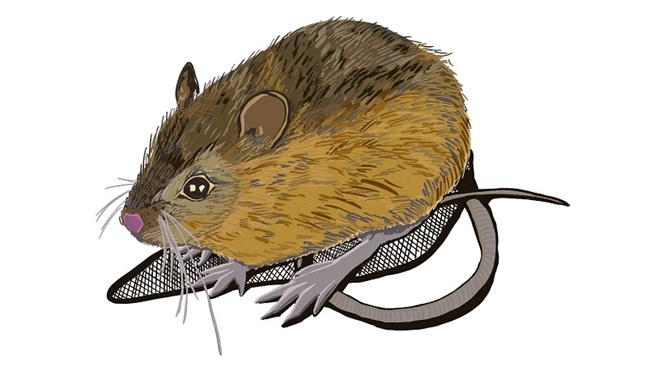Part of a series of articles titled NRCA 2022: Condition of Valles Caldera’s Natural Resources and Scenic Views.
Article
What’s furry, has big back feet, and lives by a stream? Answer: The New Mexico Meadow Jumping Mouse!

© Jennifer Frey
The New Mexico meadow jumping mouse was federally listed as endangered in 2014. The most recent count of known populations was 77 (18 in Colorado, 22 in New Mexico, and 37 in Arizona). Ten of the populations occur in the Jemez Mountains, including one in Valles Caldera National Preserve.
There are three historical observations of jumping mice in Valles Caldera, one from the mid-1970s and two from other, unconfirmed years. Then more than 40 years passed in which no jumping mice were observed (although there were no specific surveys for them). In 2018, New Mexico meadow jumping mice were confirmed in the park again!

NPS Photo
What type of habitat does a New Mexico meadow jumping mouse need?
- Primary habitat occurs along perennial streams (i.e., streams with water throughout the year) with dense herbaceous plants.
- The U.S. Fish and Wildlife Service (USFWS) considers a 100-foot-wide buffer along a perennial stream of at least 5.6 miles in length as required to support multiple, resilient jumping mouse populations. These dimensions result in a patch size of at least 68 acres.
- Connectivity of suitable habitat is needed for mouse movement, dispersal, and gene flow.
- Moist soils (saturated or nearly saturated) are an important habitat characteristic for jumping mice, but standing water deeper than 0.8 inches over large areas is undesirable (although jumping mice can and do swim short distances and may use these areas for dispersal).
- Jumping mice also require adjacent uplands with drier soils for hibernation and rearing young. New Mexico meadow jumping mice in the Jemez Mountains are active from late May or early June to late September or early October. They hibernate during the remainder of the year.
What are the biggest threats to New Mexico meadow jumping mice?
According to the USFWS, habitat loss is the biggest threat to the New Mexico meadow jumping mouse. Declines in jumping mouse populations throughout their range have been attributed to loss or damage of riparian plants due to cattle grazing, stream diversions, off-road vehicles, camping, and human social trails. Flooding in the aftermath of fires (or other factors) has also damaged jumping mouse habitat.Note that there are little to no data on New Mexico meadow jumping mice population size. Because the number of individual New Mexico meadow jumping mice needed to maintain a viable and stable population is unknown, the USFWS uses habitat patch size as a stand-in for number of individual mice.
Assessing jumping mouse habitat availability at Valles Caldera
A recent Natural Resource Condition Assessment (NRCA) through the NPS NRCA Program focused on seven resources in the park, including habitat availability of the New Mexico meadow jumping mouse. NRCAs evaluate natural resource conditions so that parks can use the best available science to manage their resources. Due to the limited amount of information available on this species’ habitat in the preserve, ecologists at Utah State University:- summarized the known occurrence of the mouse in the park and surrounding area,
- identified potential jumping mouse habitat in the park using a wetlands map produced as part of the overall NRCA project and field data collected along perennial streams in the park, and
- identified potential indicators and measures of condition for conducting future condition assessment of habitat for the mouse in the preserve.
What did we learn?
- From our mapping analysis, four patches of habitat in the park met the minimum patch size for supporting multiple, resilient jumping mouse populations. These four patches are located along three different creeks/creek complexes. Additional habitat (not meeting the minimum patch size) was located along five creeks/six creek sections.
- In Valles Caldera, jumping mice occur in herbaceous wetlands and riparian shrublands dominated by a thick herbaceous understory (although the latter is rare in the preserve).
- A jumping mouse captured in the park in 2018 did not occur in this mapped habitat, which suggests that the wetlands classification used in our mapping analysis missed small, but important, habitat patches. The mouse was found in 2018 during park surveys prior to restoration activities along this creek to improve habitat impacted by historic land uses and the severe wildfire that occurred in 2013.
- Utah State University ecologists suggested two indicators (with a total of seven measures) of jumping mouse habitat condition for a future study/condition assessment—patch size and connectivity (wetland patch size, connectivity between suitable patches), and within-patch habitat quality (presence of perennially flowing water, soil moisture, height of herbaceous plants, herbaceous plant density, and herbaceous composition).
What can park managers do with this information?
This study reviewed and summarized the available information on the New Mexico meadow jumping mouse and its habitat within the preserve, identified potential jumping mouse habitat in the preserve, and recommended potential indicators and measures for a future condition assessment of habitat for the mouse at the preserve. This information will help park personnel to further focus and/or prioritize their efforts for jumping mice in the preserve, as well as potentially collaborating with scientists working outside the preserve.
A few things YOU CAN DO to help jumping mice:It might be hard for you to help protect the New Mexico meadow jumping mouse because it has a limited distribution. However, when visiting Valles Caldera, or other areas where you know the jumping mouse exists, you can minimize your own disturbance to the mouse’s streamside habitat (especially plants) by staying on established trails. Making efforts to protect riparian habitat along rivers, streams, and creeks is a good practice in any area. Learn more about New Mexico meadow jumping mice. The more you know, the more you’ll want them around! See these additional sources of information: |
|

Information in this article was summarized from: Albright J and Others. 2022. Natural resource conditions at Valles Caldera National Preserve: Findings & management considerations for selected resources. Natural Resource Report. NPS/VALL/NRR—2022/2409. National Park Service. Fort Collins, Colorado. https://doi.org/10.36967/nrr-2293731
Read More about the 2022 Valles Caldera NRCA Project >
Visit the NRCA Program Home>
Last updated: January 12, 2023
